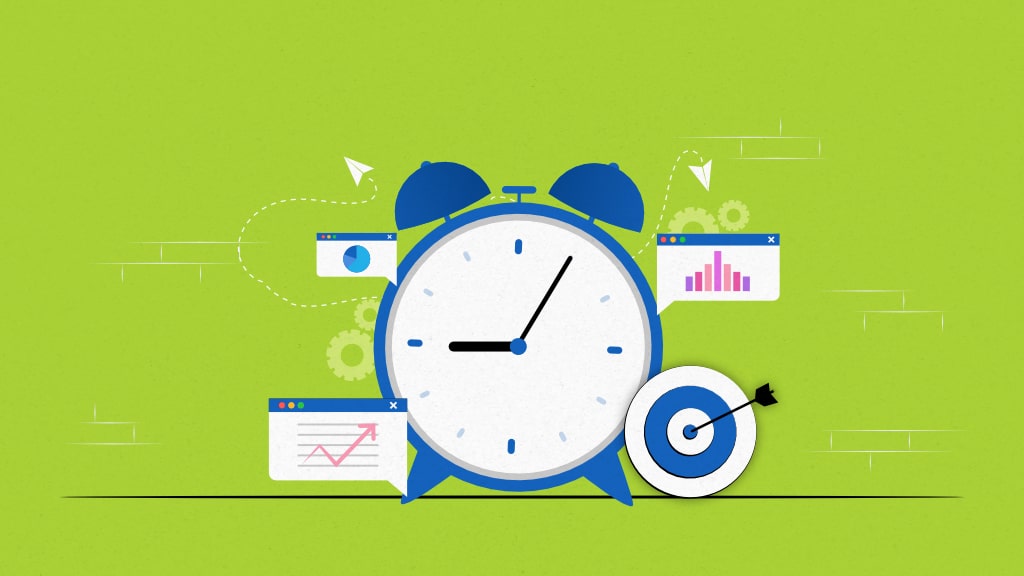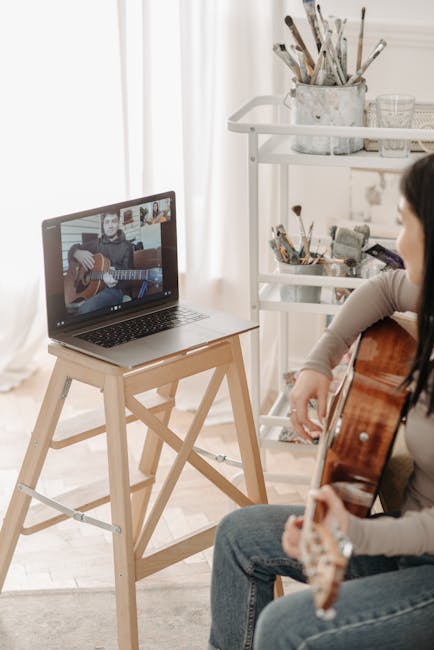Are you a busy guitarist with a jam-packed schedule and zero free time? Do you find yourself strumming your guitar for just a few minutes here and there, never able to really dive deep into tips-on-where-to-start-with-guitar/” title=”12 Incredibly Useful Tips On Where To Start With Guitar”>practicing? Well, fear not, fellow musicians, because we’ve got some tips and tricks to help you maximize your practice routine and level up your guitar skills, even in the midst of your chaotic daily life. So put down that coffee cup, pause that episode of “The Office,” and get ready to rock out like never before!
Contents
- 1 Establishing Realistic and Attainable Goals for Continuous Improvement
- 2 Creating a Structured and Efficient Practice Schedule
- 3 Incorporating the Pomodoro Technique for Enhanced Focus and Productivity
- 4 Leveraging Technology for Effective Remote Learning and Practice
- 5 Prioritizing Techniques and Repertoire for Balanced Development
- 6 Adapting Practice Sessions for Busy Lifestyles and Unpredictable Schedules
- 7 Cultivating a Growth Mindset to Overcome Plateaus and Setbacks
- 8 FAQs
- 9 Rock on, Busy Guitarists!
Establishing Realistic and Attainable Goals for Continuous Improvement
So, you want to improve, huh? That’s great! But before you start dreaming big and aiming for the stars, let’s talk about setting some realistic and attainable goals for continuous improvement. Trust me, setting goals that are too lofty can lead to disappointment quicker than you can say “I give up.”
First things first, assess where you currently stand. Take a good look at your strengths and weaknesses. Be honest with yourself – no one’s perfect (except maybe Beyoncé). Knowing your starting point will help you set goals that are challenging but not impossible to achieve.
Next, break down your larger improvement goals into smaller, actionable steps. Rome wasn’t built in a day, and neither will your improved self. Baby steps, my friend. Baby steps. Set deadlines for each step along the way and celebrate your mini-victories along the journey. You deserve it!
Remember, continuous improvement is a marathon, not a sprint. Stay consistent, stay motivated, and don’t be too hard on yourself if you stumble along the way. As long as you’re making progress, no matter how small, you’re on the right track. Keep pushing yourself, and before you know it, you’ll be a better version of yourself. Go get ’em, tiger!

Creating a Structured and Efficient Practice Schedule
So, you want to create a practice schedule that’s structured and efficient, huh? Well, buckle up because I’ve got some tips that will help you whip your routine into shape faster than you can say “sharpen those skills!”
First things first, **break down your practice sessions into manageable chunks**. Ain’t nobody got time for a marathon practice sesh that leaves you feeling like a puddle on the floor. Instead, divide your time into smaller blocks so you can focus on specific skills or exercises without burning out.
Next up, **mix it up like a smoothie**. Variety is the spice of life, my friend, and the same goes for your practice schedule. Don’t be afraid to throw in some new exercises or techniques to keep things interesting and challenging. Who knows, you might discover a hidden talent for juggling flaming batons while playing the ukulele.
And remember, **don’t forget to schedule in some breaks**. Your brain needs a breather just like your muscles do after a killer workout. So, take a moment to relax, recharge, and maybe even treat yourself to a delicious snack. After all, you’ve earned it!
Incorporating the Pomodoro Technique for Enhanced Focus and Productivity
Are you tired of starting work with good intentions, only to find yourself two hours deep into a YouTube rabbit hole? Well, fear not my distracted friends, because the Pomodoro Technique is here to save the day! This revolutionary time management method will have you laser-focused and buzzing with productivity in no time.
Picture this: you set a timer for 25 minutes (aka a Pomodoro), work like a champ until it goes off, then reward yourself with a short break. Rinse and repeat until you’ve conquered your to-do list like a boss. It’s like a game, but with less zombies and more spreadsheets.
With the Pomodoro Technique, you’ll finally have a valid excuse to nag your co-workers about interrupting your precious focus time. Just slap a “Do Not Disturb, Pomodoro in Progress” sign on your forehead and watch as your productivity skyrockets. Plus, it’s a great excuse to buy a cute little tomato-shaped timer for your desk. Who says work can’t be fashionable?
- Eliminate distractions by turning off notifications on your phone and computer. You’ll thank yourself later when you realize how many hours you’ve wasted on cat videos.
- Use your breaks wisely – stretch, hydrate, stare blankly at a wall – whatever floats your boat. Just make sure you’re ready to dive back into work when the next Pomodoro starts.
- Experiment with different Pomodoro lengths to see what works best for your flow. Maybe 25 minutes is too short, or maybe you’re a superhero who can power through 50-minute intervals like a champ. The possibilities are endless!

Leveraging Technology for Effective Remote Learning and Practice
When it comes to remote learning and practice, technology is your best friend! With the right tools and resources, you can turn your living room into a virtual classroom or practice space. So, why not embrace the power of technology and take your learning to the next level?
Here are some tips for leveraging technology effectively:
- Find a reliable video conferencing platform: Whether you’re attending a virtual class or practicing with a group, a good video conferencing platform is essential. Zoom, Google Meet, or Microsoft Teams are great options to consider.
- Use online collaboration tools: Tools like Google Docs, Trello, or Slack can help you stay organized and work on group projects seamlessly. Plus, they make it easy to communicate with your classmates or colleagues.
- Explore virtual reality (VR) simulations: Want to practice hands-on skills from the comfort of your home? Consider using VR simulations for a more immersive learning experience. Whether you’re practicing surgical procedures or conducting virtual experiments, the possibilities are endless!
Remember, technology is not a substitute for the real thing, but it can definitely enhance your learning and practice experiences. So, don’t be afraid to get creative and experiment with different tools and resources. Who knows, you might just discover a new way of learning that works best for you!

Prioritizing Techniques and Repertoire for Balanced Development
When it comes to developing a well-rounded skill set in any area, prioritizing techniques and repertoire is key. Think of it like building a balanced diet – you need a mix of different elements to ensure you’re hitting all the right notes. Here are some strategies to help you achieve that harmonious balance:
Technique Tip: Incorporate a variety of exercises into your practice routine. From scales to arpeggios to finger exercises, mixing it up will keep your fingers on their toes (or, um, fingertips).
Repertoire Recommendation: Don’t just stick to one genre of music. Expand your horizons by exploring different styles and time periods. Jazz, classical, pop – the more diverse your repertoire, the more well-rounded your skills will become.
Remember, balance is key. Don’t neglect one aspect of your development at the expense of another. By prioritizing techniques and repertoire in a thoughtful and strategic way, you’ll be well on your way to becoming a musical powerhouse.
Adapting Practice Sessions for Busy Lifestyles and Unpredictable Schedules
So, you’ve got a crazy hectic schedule and finding time to practice seems like an impossible task? Fear not, we’ve got some tips to help you adapt your practice sessions to fit into your busy lifestyle.
First off, embrace the power of micro-practice sessions. Instead of trying to find one long chunk of time to practice, sneak in quick 10-15 minute practice sessions throughout your day. Whether it’s during your lunch break, while waiting for your coffee to brew, or even while you’re brushing your teeth - every little bit counts!
Another tip is to prioritize your practice sessions. Identify the most important skills or pieces you need to work on, and focus on those first. Don’t waste time on things that aren’t going to have a big impact on your progress. Remember, quality over quantity!
Lastly, be flexible and adaptable. Life is unpredictable, and sometimes things just don’t go according to plan. If you miss a scheduled practice session, don’t beat yourself up about it. Just make up for it later in the day or week. The key is to keep moving forward, no matter how small the steps may be. You’ve got this!
Cultivating a Growth Mindset to Overcome Plateaus and Setbacks
So, you’ve hit a plateau or encountered a setback in your journey towards your goals. Fear not, my fellow wanderer! It’s time to roll up your sleeves, dig deep, and cultivate that growth mindset to conquer all obstacles that come your way.
First things first, let’s kick that negative self-talk to the curb. No more “I can’t” or “I’m not good enough” nonsense. It’s time to flip the script and replace those self-limiting beliefs with some serious positive vibes. Repeat after me: “I can and I will overcome this plateau/setback with my incredible awesomeness!”
Next up, embrace the power of yet. That’s right, the magical word that holds the key to unlocking endless possibilities. Haven’t reached your goal YET? No worries, you’re on your way. Each setback is just a stepping stone towards your ultimate success. Keep pushing forward and trust that the journey is just as important as the destination.
And last but not least, surround yourself with a tribe of fellow growth-minded warriors. Share your struggles, celebrate your victories, and lift each other up when the going gets tough. Remember, we’re all in this crazy adventure called life together, so why not enjoy the ride with some like-minded comrades by your side?
FAQs
How can I find time to practice guitar when I have a busy schedule?
Well, if you can find time to binge-watch a series on Netflix, you can definitely find time to practice guitar. Wake up half an hour earlier, practice during your lunch break, or sneak in a few minutes before bed. Every little bit counts!
What are some ways I can stay motivated to practice regularly?
One word: goals. Set realistic, achievable goals for yourself and track your progress. Whether it’s learning a new song, mastering a difficult chord progression, or just improving your scales, having something to work towards will keep you motivated.
How can I make the most out of my practice session, even if it’s short?
Quality over quantity, my friend. Focus on specific techniques or exercises that you want to improve on, rather than aimlessly strumming along to your favorite songs. A focused 15-minute practice session can be more effective than an hour of mindless noodling.
What are some tips for maximizing my practice routine when I’m feeling burnt out?
Mix it up! Don’t be afraid to switch things up in your practice routine. Try learning a new genre of music, experimenting with different techniques, or even taking a break from playing altogether. Sometimes a little change can reignite your passion for playing.
How can I make the most out of limited practice time?
Prioritize, prioritize, prioritize. Identify the areas of your playing that need the most work and focus on those. Don’t waste your precious practice time noodling around aimlessly – be intentional and focused in your practice approach.
Rock on, Busy Guitarists!
Congratulations, you’ve made it to the end of our article on maximizing your practice routine! Now that you’ve armed yourself with these tips and tricks, there’s no excuse for not making time to hone your guitar skills. Remember, even just a few minutes of focused practice each day can make a world of difference. So put on your favorite guitar face and get shredding! And if all else fails, just remember: it’s all about the attitude and the power chords. Happy strumming!



